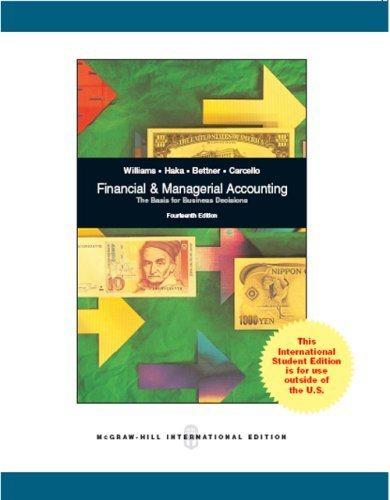Question
Please do not plagiarize, not even just rearranging words. Question 1: Discuss the effects of four of the five major accounting assumptions on the accounting
Please do not plagiarize, not even just rearranging words.
Question 1:
Discuss the effects of four of the five major accounting assumptions on the accounting process.
Identify and completely discusses all five of the major accounting assumptions.
Question 2:
There are other basic accounting concepts that affect accounting for entities. List and describe four of the five concepts' impact on the accounting process.
List and describe all five concepts' impact on the accounting process.
Question 3:
GAAP set forth standards or methods for presenting financial accounting information. List and describe the purpose for four of the five major accounting principles.
List and describe all five major accounting principles.
Question 4:
In certain instances, companies do not strictly apply accounting principles because of modifying conventions or constraints. Identify and describe the impact on the accounting process of the three modifying conventions as presented in the Accounting Principles: A Business Perspective, Financial Accounting text.
Provide an example of where each modifying convention or constraint may be employed.
Question 5:
Correctly state the letter or letters of the principle(s), assumption(s), or concept(s) used to justify the accounting procedure followed for at least four or five of the accounting procedures. These procedures are all correct.
Principle(s), assumption(s), concept(s):
A. Business entity. B. Conservatism. C. Earning principle of revenue recognition. D. Going concern (continuity). E. Exchange-price (cost) principle. F. Matching principle. G. Period cost (or principle of immediate recognition of expense). H. Realization principle. I. Stable dollar assumption.
Accounting procedures:
1. Inventory is recorded at the lower of cost or market value. 2. A truck purchased in January was reported at 80 percent of its cost even though its market value at year-end was only 70 percent of its cost. 3. The collection of $40,000 of cash for services to be performed next year was reported as a current liability. 4. The president's salary was treated as an expense of the year even though he spent most of his time planning the next two years' activities. 5. No entry was made to record the company's receipt of an offer of $800,000 for land carried in its accounts at $435,000. 6. A supply of printed stationery, checks, and invoices with a cost of $8,500 was treated as a current asset at year-end even though it had no value to others. 7. A tract of land acquired for $180,000 was recorded at that price even though it was appraised at $230,000, and the company would have been willing to pay that amount. 8. The company paid and charged to expense the $4,200 paid to Craig Nelson for rent of a truck owned by him. Craig Nelson is the sole stockholder of the company.
Correctly state the letter or letters of the principle(s), assumption(s), or concept(s) used to justify the accounting procedure followed for at least six or seven of the accounting procedures.
Correctly state the letter or letters of the principle(s), assumption(s), or concept(s) used to justify the accounting procedure followed for all eight of the accounting procedures.
Question 6:
Describe the major differences between income statements for a service company and a merchandise company.
In detail, describe how the gross margin for a merchandising company is determined.
Question 7:
As part of the calculation for cost of goods sold it is necessary to determine the value of goods on hand, termed merchandise inventory. Accountants use two basic methods for determining the amount of merchandise inventory. Identify the two methods and describe the circumstances (including examples of users of each method) under which each method would be used.
Describe the computation necessary to arrive at the cost of goods sold figure on a merchandising company's income statement.
Question 8:
Contrast an unclassified income statement with the components of a classified income statement.
Explain why a company would choose to present its income statement data in a classified format. Identify and describe the major sections of a classified income statement
In each of the following equations supply the missing term(s):
- Net sales = Gross sales - (______________________ + Sales returns and allowances).
- Cost of goods sold = Beginning inventory + Net cost of purchases - ________ ________.
- Gross margin = ________ ________ - Cost of goods sold.
- Income from operations = __________ _________ - Operating expenses.
- Net income = Income from operations + _________ ________ - ________ ________.
Question 9:
What is gross margin? How is it calculated?
Why might management be interested in the use of the tool for analyzing accounting information?
Using a bit of research, which industry presents a notoriously low gross margin percentage, and conversely, name an industry that traditionally experiences a high gross margin percentage.
Step by Step Solution
There are 3 Steps involved in it
Step: 1

Get Instant Access to Expert-Tailored Solutions
See step-by-step solutions with expert insights and AI powered tools for academic success
Step: 2

Step: 3

Ace Your Homework with AI
Get the answers you need in no time with our AI-driven, step-by-step assistance
Get Started


